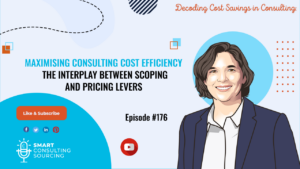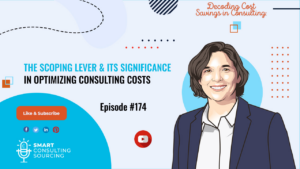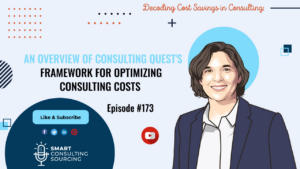Welcome back to Smart Consulting Sourcing, the definitive guide to mastering the way consulting services are utilised, procured and managed. I’m Helene, your host, and I’m excited to have you join us for another insightful episode in our series on consulting cost optimization. Today, we’re diving into pricing levers.
What Are Pricing Levers?
What exactly are pricing levers, you might ask? These are key negotiation tools for consulting projects, but with a unique twist—which I’ll reveal shortly.
Recap of Previous Episodes
But first, let’s recap our previous episode’s discussion on scoping levers and their significance throughout the life of a project. It’s important to remember that effective scoping follows strategic demand management, ensuring that your efforts are focused on initiatives that deliver significant value to your organization. We explored how scoping levers help tailor the project’s focus, depth, breadth, and the consultant’s approach and staffing to align closely with high-value activities.
If you missed this episode or any others in our series that outline strategies for optimizing consulting expenditures, I encourage you to catch up. All episodes are available on major podcast platforms and YouTube. For those who prefer reading, visit our Thought Leadership section at consultingquest.com. If you enjoy our content, please don’t forget to like and subscribe.
Understanding Consulting Costs
Thank you for tuning in today. At Consulting Quest, we’re dedicated to helping you leverage consulting to accelerate your transformation. Now, let’s return to our main topic for today: pricing.
Now, many of you might think pricing is pretty straightforward, right? You see a price, you know the supplier is making a margin, and naturally, you aim to push that margin down to snag a better deal. Simple enough.
But here’s the twist: that typical approach doesn’t quite fly in the consulting world. Yes, consulting is known for its high margins, but don’t expect more than a 5 to 10% discount from consulting firms. Push beyond that, and you’re not just talking discounts—you’re looking at de-scoping. This means subtle tweaks in scope or adjustments in staffing to bring down the price.
Remember, consulting costs hinge largely on two things: the workload and the seniority of the consultants involved. If you’re not seasoned in crafting proposals, these adjustments can be tough to spot. That’s why the brute-force approach of simply slashing prices doesn’t cut it here. It’s a bit more nuanced, which makes it all the more fascinating, doesn’t it?
Insider Tricks for Negotiation
Alright, let’s dive into some insider tricks that we often employ when assisting our clients. You might want to jot these down! As I mentioned previously, negotiating in consulting isn’t a straightforward, linear process of scope first, price second. There’s quite a bit of give and take involved.
Leveraging Competition
First up, let’s talk about leveraging competition—arguably the most effective strategy in our toolkit. Here’s why it’s so powerful: Leveraging competition not only gives us comparables for better decision-making but also helps lower the anchor point, keeping incumbents on their toes. Here’s how you can make this work to your advantage:
Create Relevant Competition
The key here is to invite consulting firms to your Request for Proposal (RFP) that truly have a shot at winning the gig. This means choosing firms that not only have the right expertise and references but also the capacity to handle your project. While it’s wise not to name-drop the competitors in your RFP, you can drop subtle hints during briefings, Q&A sessions, and while analysing proposals. For instance, mentioning that other firms have posed sharp questions or suggested smart tweaks can really keep everyone on their toes, pushing them to sharpen their pencils on their proposals and pricing.
Include Challengers in the Mix
Shake things up by including both new and established players in your RFP. Think about inviting up-and-coming firms alongside the usual suspects or mixing smaller, budget-friendly consultants with the big industry names. This not only spices up the competition but also encourages more aggressive pricing, potentially leading to better deals. It’s a great way to ensure you’re not only getting cost-effective solutions but also innovative ideas and approaches, striking the right balance between quality and cost.
Leveraging Rebates and Discounts
Next, let’s explore rebates and discounts. Using rebates and discounts effectively allows organizations to maximize value, taking into account the slim margins consulting firms typically leave for negotiation and their response to seasonal variations.
Volume Rebates
The concept here is simple: the longer the engagement, the lower the daily fee should ideally be. Consulting firms often prefer a slight price reduction in exchange for the stability of continuous work. It’s common practice, similar to volume-based rebates in a Master Service Agreement (MSA), to expect lower rates for longer projects. You might set up a system where discounts kick in only after reaching a certain spend threshold, but discounts of up to 15% are not uncommon, with commitments of over $1 million or $2 million. Typically, smaller firms tend to offer more generous discounts compared to larger ones.
Commercial Efforts
Never take the list price at face value. It’s usual to ask for a discount, and consulting firms generally anticipate this. Many are ready to offer a discount ranging from 5% to 10%. This approach leverages a typical sales strategy where the initial price includes some room for negotiation. By making it standard practice to negotiate, you often secure better terms and pricing, which optimizes your spending without sacrificing the quality or scope of the services. The discounts are often already factored into the pricing because consultants expect you to negotiate—so make sure you do.
Leveraging Creative Fee Structures
Now let’s delve into our third lever, the Creative Fee Structure. This method is not widely used, often because many organizations either aren’t sure how or when to use it, or they use it incorrectly. Traditional consulting agreements usually involve flat fees, which make expenses predictable but can be hard to justify, especially when budgets are tight and outcomes are uncertain. By linking consulting fees to actual results, organizations can ensure a better return on investment, increasing their readiness to invest if the expected value is realized.
Performance-based Fees
These fees are designed around specific, both tangible and intangible, benchmarks. The goal is to incentivize the consulting firm to deliver top-notch performance throughout the project. There’s usually a lower upfront fee that ensures a basic payment regardless of outcomes, but if the performance targets are met or surpassed, the consulting firm can earn significantly more than with a standard flat fee arrangement. This setup ensures that consultants are properly rewarded for exceptional work while providing clients with protection against unsatisfactory outcomes.
Success Fees
These fees are strictly tied to definite outcomes, such as realized savings, increased sales, or other measurable business impacts. This compensation model is fundamentally a “pay for performance” system, where the consultant’s earnings are directly linked to the success of the client. This can be particularly appealing when project goals are straightforward, and the results are quantifiable.
Before we move on, here’s a piece of advice. Only use this lever if you’re ready to share the gains with the consultants. This isn’t just a tactic to reduce costs; in fact, these fees often end up being higher than typical flat fees if the consultants meet their targets. And speaking from experience, always honour your commitments. If you’ve agreed to a bonus upon successful delivery, and the consultants deliver, then pay that bonus.
Failure to honour your agreements not only brands you as a poor client but, in the tight-knit world of consulting, word spreads fast. And interestingly enough, consultants tend to charge more to their more difficult clients. So, in the long run, you might end up facing the exact opposite of what you intended. Perhaps it’s a bit of karma?
Other Negotiation Levers
Alright, let’s dive into some more negotiation levers that, while perhaps secondary, can still play a significant role in reducing your consulting costs. These might not offer instant big savings, but they sure can add up to substantial optimizations over time.
T&E Costs Optimization
Travel and Expenses (T&E) traditionally make up a notable percentage of project costs, which doesn’t always make sense. Some companies might even throw in an all-inclusive offer. Especially post-pandemic, the acceptance of remote work has changed the game. T&E should be minimal if consultants are working remotely. It’s crucial to align the T&E model with the proposed approach. Implement measures like capping expenses, adhering to company policies, and requiring approvals to further squeeze T&E costs. Keep in mind, T&E pricing might not have caught up with these new norms, so compare wisely between all-inclusive and at-cost T&E quotes. You can even use historical data from past projects to help gauge what’s fair.
Target Must Prices
Setting “Target Must Prices” can anchor your negotiations, starting discussions from an optimized price point based on thorough market research and your own budget limits. This is especially helpful when responses to the same RFP can vary widely depending on the project’s scope and the level of support needed. If your budget and timeline are tight, simplify things: set a target price upfront. Many hesitate to reveal their budget, fearing that consultants will always hit the ceiling, leaving potential savings on the table. But remember, that’s what scoping negotiations are for. This also helps you distinguish between consultants who are willing to work within your parameters and those who might be looking to maximize the project scope.
Rate Card Negotiations
Rate cards are a godsend for long-term projects where you might see consultant turnover or need extensions. These cards should detail consultant profiles and standard rates, helping to streamline processes for project renewals or staff additions. Use pricing benchmarks to understand market rates and negotiate more favourable terms. However, remember that lower rate cards don’t automatically mean lower overall project costs. More experienced consultants might deliver results quicker and with fewer people, offering you a higher return on investment in the long run.
Conclusion
To wrap up, we’ve explored several powerful levers you can use to effectively reduce your costs. As you’ve seen, my approach isn’t just about slashing numbers; it’s about optimizing costs while still focusing sharply on value. A common critique of procurement in consulting is that driving down costs often means a dip in value delivered. However, this doesn’t have to be the case. The secret is to collaborate with consultants to craft the best proposal possible, not to work against them. So, let’s ditch the tough guy act—it tends to bring more headaches than savings.
And just to set the record straight—while it’s important to stay sharp and not take every word from consultants as gospel, remember that most consultants are genuinely honest and hardworking folks who take great pride in their work. Yes, they’re in it to make a business, but then again, aren’t we all?
Here’s the key takeaway: Never negotiate pricing or scoping in isolation. Always consider both, because scoping directly affects pricing and vice versa. If you take just one thing from today’s podcast, let it be this—you’ll be far better off!
Further Resources
Now before I end today’s episode, I’d like to leave you with a few useful resources for you to chew on till we meet again next week. Firstly, I would highly recommend heading over to consultingquest.com and read through our insight titled “Pricing Benchmark in Consulting – What Makes It An Indispensable Tool for Procurement”. In this insight, we explore the significance of pricing benchmarking in consulting procurement and how this indispensable tool facilitates fair pricing negotiations, how it ensures optimal value for services rendered, and how it enhances the decision-making processes.
Another resourceful read that I would recommend is our insight on consource.io titled “Negotiate Your Consulting Agreement Like a Boss – 4 Kickass Strategies”. In this piece, we unlock the secrets to mastering your consulting agreement with 4 kickass negotiation strategies. Through this piece, you will also discover how to secure the best terms, protect your interests, and how be a pro at the negotiating game.
And finally, to this round this all up, I’d recommend reading one of our latest pieces titled “How to Decode the Price of a Project with these 5 Simple Tactics?”. This insight will help you break down and decode costs with ease. You will also learn how to navigate project expenses like a pro and how to make smarter and cost-effective decisions for any project.
And in case you are looking for more such topics, then you should check out consultingquest.com and consource.io. They’re packed with all sorts of helpful content like insights, podcasts, e-books, and more. Whether you’re eager to boost your transformation or just want to make smarter buying decisions, you’ll find plenty of valuable information there.
Alright folks, that’s all for today. Next week, we’ll dive deeper into how these sets of levers intertwine and I’ll share some practical strategies for using them effectively.
And before you go, don’t forget to hit that subscribe button for all the latest episodes and updates. And thank you for tuning in to today’s episode! Your thoughts and feedback mean the world to me, so don’t hesitate to reach out on LinkedIn or via email at hcl@consultingquest.com. I’m always up for a chat! And if there are any topics you’d love to hear about in future episodes, send them my way too. Can’t wait to hear from you!
Until next time, stay safe and keep up the smart consulting sourcing game. Au revoir for now, and happy sourcing!
FAQs
What are pricing levers in consulting?
Pricing levers in consulting refer to negotiation tools and strategies used to manage and optimize consulting costs effectively. These can include leveraging competition, utilizing rebates and discounts, and implementing creative fee structures.
How can leveraging competition reduce consulting costs?
By inviting multiple consulting firms to bid on a project and subtly hinting at the competition during briefings, clients can encourage firms to offer more competitive pricing and innovative solutions, ultimately driving down costs.
What are volume rebates in consulting agreements?
Volume rebates involve negotiating lower daily fees for longer engagements. Consulting firms may offer discounts for projects that guarantee continuous work, similar to volume-based rebates in a Master Service Agreement.
How do performance-based fees work?
Performance-based fees link consultant compensation to specific benchmarks, incentivizing high performance. This structure often involves a lower upfront fee with the potential for higher earnings if performance targets are met or exceeded.
What are T&E costs, and how can they be optimised?
Travel and Expenses (T&E) costs cover expenses related to travel and other project-related expenditures. Optimizing T&E involves minimizing travel through remote work, capping expenses, and adhering to company policies to reduce overall costs.
What are rate cards, and why are they important?
Rate cards detail consultant profiles and standard rates, helping streamline processes for project renewals or staff additions. They provide a basis for negotiating favourable terms and managing long-term project costs effectively.







